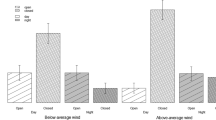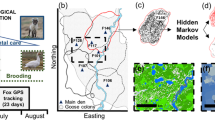Abstract
The landscape of fear is an important driver of prey space use. However, prey can navigate the landscape of fear by exploiting temporal refuges from predation risk. We hypothesized that diel patterns of predator and prey movement and space use would be inversely correlated due to temporal constraints on predator habitat domain. Specifically, we evaluated habitat selection and activity of the vicuña and its only predator, the puma, during three diel periods: day, dawn/dusk, and night. Pumas selected the same habitats regardless of diel period—vegetated and rugged areas that feature stalking cover for pumas—but increased their activity levels during dawn/dusk and night when they benefit from reduced detection by prey. Vicuñas avoided areas selected by pumas and reduced activity at night, but selected vegetated areas and increased activity by day and dawn/dusk. Vicuña habitat selection and movement strategies appeared to reduce the risk of encountering pumas; movement rates of pumas and vicuñas were negatively correlated across the diel cycle, and habitat selection was negatively correlated during dawn/dusk and night. Our study shows that an ambush predator’s temporal activity and space use patterns interact to create diel refugia and shape the antipredator behaviors of its prey. Importantly, it is likely the very nature of ambush predators’ static habitat specificity that makes predator activity important to temporally varying perceptions of risk. Prey which depend on risky habitats for foraging appear to mitigate risk by feeding when they can more easily detect predators and when predators are least active.



Similar content being viewed by others
References
Bogdan V, Jůnek T, Vymyslická P (2016) Temporal overlaps of feral cats with prey and competitors in primary and human-altered habitats on Bohol Island, Philippines. PeerJ 4:e2288. https://doi.org/10.7717/peerj.2288
Boyce MS, Vernier PR, Nielsen SE, Schmiegelow F (2002) Evaluating resource selection functions. Ecol Model 157:281–300. https://doi.org/10.1016/S0304-3800(02)00200-4
Burkepile D, Burns C, Tambling C, Amendola E, Buis G, Govender N, Nelson V, Thompson D, Zinn A, Smith M (2013) Habitat selection by large herbivores in a southern African savanna: the relative roles of bottom-up and top-down forces. Ecosphere 4:1–19. https://doi.org/10.1890/ES13-00078.1
Burnham KP, Anderson DR (2002) Model selection and multimodal inference: a practical information-theoretic approach, 2nd edn. Springer, New York
Calenge C (2006) The package “adehabitat” for the R software: a tool for the analysis of space and habitat use by animals. Ecol Model 197:516–519. https://doi.org/10.1016/j.ecolmodel.2006.03.017
Courbin N, Loveridge A, Fritz H, Macdonald D, Patin R, Valeix M, Chamaillé-Jammes S (2019) Zebra diel migrations reduce encounter risk with lions at night. J Anim Ecol 88:92–101. https://doi.org/10.1111/1365-2656.12910
Creel S, Winnie J, Christianson D, Liley S (2008) Time and space in general models of antipredator response: tests with wolves and elk. Anim Behav 76:1139–1146. https://doi.org/10.1016/j.anbehav.2008.07.006
Crosmary W-G, Valeix M, Fritz H, Madzikanda H, Côté S (2012) African ungulates and their drinking problems: hunting and predation risks constrain access to water. Anim Behav 83:145–153. https://doi.org/10.1016/j.anbehav.2011.10.019
Dodson S (1990) Predicting diel vertical migration of zooplankton. Limnol Oceanogr 35:1195–1200. https://doi.org/10.4319/lo.1990.35.5.1195
Donadio E, Buskirk S (2016) Linking predation risk, ungulate antipredator responses, and patterns of vegetation in the high Andes. J Mammal 97:966–977. https://doi.org/10.1093/jmammal/gyw020
Donadio E, Buskirk SW, Novaro AJ (2012) Juvenile and adult mortality patterns in a vicuña (Vicugna vicugna) population. J Mammal 95:1536–1544
Dröge E, Creel S, Becker M, M’soka J (2017) Risky times and risky places interact to affect prey behaviour. Nat Ecol Evol 1:1123–1128. https://doi.org/10.1038/s41559-017-0220-9
Fischhoff I, Sundaresan S, Cordingley J, Rubenstein DI (2007) Habitat use and movements of plains zebra (Equus burchelli) in response to predation danger from lions. Behav Ecol 18:725–729. https://doi.org/10.1093/beheco/arm036
Franklin WL (1974) The social behavior of the vicuña. In: Geist V, Walther F (eds) The behaviour of ungulates and its relation to management. IUCN Publications, Morges, Switzerland, pp 477–487
Gaillard JM, Festa-Bianchet M, Yoccoz NG, Loison A, Toïgo C (2000) Temproral variation in fitness components and population dynamics of large herbivores. Annu Rev Ecol Syst 31:367–393. https://doi.org/10.1146/annurev.ecolsys.31.1.367
Geraldi NR, Macreadie PI (2013) Restricting prey dispersal can overestimate the importance of predation in trophic cascades. PLoS One 8:e55100. https://doi.org/10.1371/journal.pone.0055100
Griffin P, Griffin S, Waroquiers C, Mills S (2005) Mortality by moonlight: predation risk and the snowshoe hare. Behav Ecol 16:938–944. https://doi.org/10.1093/beheco/ari074
Harmsen B, Foster R, Silver S, Ostro L, Doncaster CP (2011) Jaguar and puma activity patterns in relation to their main prey. Mamm Biol Z Säugetierkd 76:320–324. https://doi.org/10.1016/j.mambio.2010.08.007
Hebblewhite M, Merrill E (2007) Multiscale wolf predation risk for elk: does migration reduce risk? Oecologia 152:377–387. https://doi.org/10.1007/s00442-007-0661-y
Hebblewhite M, Merrill EH (2009) Trade-offs between predation risk and forage differ between migrant strategies in a migratory ungulate. Ecology 90:3445–3454. https://doi.org/10.1890/08-2090.1
Hebblewhite M, Merrill E (2011) Demographic balancing of migrant and resident elk in a partially migratory population through forage–predation tradeoffs. Oikos 120:1860–1870. https://doi.org/10.1111/j.1600-0706.2011.19436.x
Kohl MT, Stahler DR, Metz MC, Forester JD, Kauffman MJ, Varley N, White PJ, Smith DW, MacNulty DR (2018) Diel predator activity drives a dynamic landscape of fear. Ecol Monogr. https://doi.org/10.1002/ecm.1313
Kotler BP, Brown J, Mukherjee S, Berger-Tal O, Bouskila A (2010) Moonlight avoidance in gerbils reveals a sophisticated interplay among time allocation, vigilance and state-dependent foraging. Proc R Soc Biol Sci 277:1469–1474
Leblond M, Dussault C, Ouellet J (2010) What drives fine-scale movements of large herbivores? A case study using moose. Ecography 33:1102–1112. https://doi.org/10.1111/j.1600-0587.2009.06104.x
Loarie S, Tambling C, Asner G (2013) Lion hunting behaviour and vegetation structure in an African savanna. Anim Behav 85:899–906. https://doi.org/10.1016/j.anbehav.2013.01.018
Lone K, Mysterud A, Gobakken T, Odden J, Linnell J, Loe L (2017) Temporal variation in habitat selection breaks the catch-22 of spatially contrasting predation risk from multiple predators. Oikos 126:624–632. https://doi.org/10.1111/oik.03486
Lynch E, Northrup J, McKenna M, Anderson C, Angeloni L, Wittemyer G (2015) Landscape and anthropogenic features influence the use of auditory vigilance by mule deer. Behav Ecol 26:75–82. https://doi.org/10.1093/beheco/aru158
Makin D, Chamaillé-Jammes S, Shrader A (2017) Herbivores employ a suite of antipredator behaviours to minimize risk from ambush and cursorial predators. Anim Behav 127:225–231. https://doi.org/10.1016/j.anbehav.2017.03.024
Moll R, Redilla K, Mudumba T, Muneza A, Gray S, Abade L, Hayward M, Millspaugh J, Montgomery R (2017) The many faces of fear: a synthesis of the methodological variation in characterizing predation risk. J Anim Ecol 86:749–765. https://doi.org/10.1111/1365-2656.12680
Northrup JM, Hooten MB, Anderson CR Jr, Wittemyer G (2013) Practical guidance on characterizing availability in resource selection functions under a use–availability design. Ecology 94:1456–1463. https://doi.org/10.1890/12-1688.1
Palmer MA, Fieberg J, Swanson A, Kosmala M, Packer C (2017) A “dynamic” landscape of fear: prey responses to spatiotemporal variations in predation risk across the lunar cycle. Ecol Lett 20:1364–1373. https://doi.org/10.1111/ele.12832
Perrig PL, Donadio E, Middleton AD, Pauli JN (2017) Puma predation subsidizes an obligate scavenger in the high Andes. J Appl Ecol 54:846–853. https://doi.org/10.1111/1365-2664.12802
Preisser EL, Orrock JL, Schmitz OJ (2007) Predator hunting mode and habitat domain alter nonconsumptive effects in predator–prey interactions. Ecology 88:2744–2751. https://doi.org/10.1890/07-0260.1
Prugh L, Golden C (2014) Does moonlight increase predation risk? Meta-analysis reveals divergent responses of nocturnal mammals to lunar cycles. J Anim Ecol 83:504–514. https://doi.org/10.1111/1365-2656.12148
Sarno RJ, Grigione MM, Arvidson LD (2008) Lack of response of an open-habitat ungulate to the presence of predator urine. Rev Chil Hist Nat 81:179–183. https://doi.org/10.4067/S0716-078X2008000200003
Schmitz OJ (2005) Behavior of predators and prey and links with population-level processes. Oxford University Press, New York
Schmitz O, Miller J, Trainor A, Abrahms B (2017) Toward a community ecology of landscapes: predicting multiple predator–prey interactions across geographic space. Ecology 98:2281–2292. https://doi.org/10.1002/ecy.1916
Smith JA, Donadio E, Pauli JN, Sheriff MJ, Bidder OR, Middleton AD (2019) Habitat complexity mediates the predator-prey space race. Ecology
Soria-Díaz L, Monroy-Vilchis O, Zarco-González Z, Soria-Díaz L, Monroy-Vilchis O, Zarco-González Z (2016) Activity pattern of puma (Puma concolor) and its main prey in central Mexico. Anim Biol 66:13–20. https://doi.org/10.1163/15707563-00002487
Valeix M, Loveridge AJ, Ecology S, Davidson Z, Murindagomo F, Fritz H, Macdonald DW (2009) Behavioral adjustments of African herbivores to predation risk by lions: spatiotemporal variations influence habitat use. Ecology 90:23–30. https://doi.org/10.1890/08-0606.1
Williams TM, Wolfe L, Davis T, Kendall T, Richter B, Wang Y, Bryce C, Elkhaim GH, Wilmers CC (2014) Instantaneous energetics of puma kills reveal advantage of felid sneak attacks. Science 346:81–85. https://doi.org/10.1126/science.1254885
Wilson M, O’Connell B, Brown C, Guinan J, Grehan A (2007) Multiscale terrain analysis of multibeam bathymetry data for habitat mapping on the continental slope. Mar Geod 30:3–35. https://doi.org/10.1080/01490410701295962
Wu Y, Wang H, Wang H, Feng J (2018) Arms race of temporal partitioning between carnivorous and herbivorous mammals. Sci Rep 8:1713. https://doi.org/10.1038/s41598-018-20098-6
Acknowledgements
We thank J. Gallo (San Guillermo National Park) for logistic support; B. Jansen and O. Alcumbrac for assistant with wildlife captures; and San Guillermo rangers F. Marinero, J. Esquivel, I. Esquivel, J. Cavallero, Hugo Godoy, and Anibal Saavedra, as well as San Guillermo Provincial Reserve personnel and 18 volunteers for field and laboratory assistance. P. Perrig and B. Varela contributed significantly to data collection. We thank O. Bidder for compiling environmental layers. Research permits were issued by the Argentinean National Park Administration. This work was supported by the National Geographic Society (CRE 9341-13), Devonwood Foundation, Rufford Foundation, Wildlife Conservation Society, Species Conservation Foundation (Germany), and Yale Institute for Biospheric Studies.
Author information
Authors and Affiliations
Contributions
JAS, ED, and ADM conceived of the study. ED, JNP, MJS, and ADM provided materials. ED, JNP, and ADM collected the data. JAS analyzed the data. JAS and ADM wrote the manuscript, and ED, JNP, and MJS contributed to revisions.
Corresponding author
Additional information
Communicated by Christopher Whelan.
Electronic supplementary material
Below is the link to the electronic supplementary material.
Rights and permissions
About this article
Cite this article
Smith, J.A., Donadio, E., Pauli, J.N. et al. Integrating temporal refugia into landscapes of fear: prey exploit predator downtimes to forage in risky places. Oecologia 189, 883–890 (2019). https://doi.org/10.1007/s00442-019-04381-5
Received:
Accepted:
Published:
Issue Date:
DOI: https://doi.org/10.1007/s00442-019-04381-5




